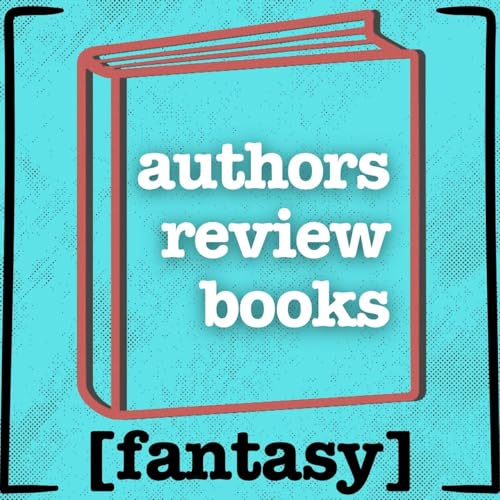Books featured in this episodeDragons and Aces by J. G. Gates (find it on Amazon.com)Empire of the Dawn by Jay Kristoff (find it on Amazon.com)Empire of the Damned by Jay Kristoff (find it on Amazon.com)TranscriptJ. G. Gates:Hello and welcome to Authors Review Books, your show where, as the name implies, your favorite authors share the books they love. I am bestselling author J. G. Gates, author of over a dozen novels, and most recently, you might have heard of Dragons and Aces. It’s an enemy-celebrity story about a badass dragon rider and a dashing biplane pilot from enemy nations. It has banter, it has spice, and if you loved Fourth Wing, then it might just be your next favorite dragon read. So, check it out.Our featured new release today is Empire of the Dawn by Jay Kristoff, which is book three of the Empire of the Vampire series. Gabriel de Leon has lost his family, his faith, and his last hope of ending the endless night—the Holy Grail, Dior.With no desire left but vengeance, he and a band of loyal brothers journey into the war-torn heart of the Augustan Empire to claim the life of the Forever King. Unbeknownst to the last Silver Saint, the Grail still lives, speeding toward Augustan’s besieged capital in the frail hopes of ending day’s death forever. But deadly treachery awaits within the halls of power, and the Forever King’s legions march ever closer. Gabriel and Dior will be drawn into the final battle that will shape the very fate of the empire. But as the sun sets for what may be the last time, there will be no one left for them to trust.J. G. Gates:And that is a book that just came out, and it’s actually a perfect transition because the book I’m reviewing today is book two of that series, which is Empire of the Damned, book two of Empire of the Vampire, again by Jay Kristoff. So, what is this book about? Can I summarize it without giving any spoilers? Well, again, it’s book two of the series, so I don’t want to give too much away.Gabriel de Leon is a Silver Saint, part of an almost monastic order that battles vampires. He is known throughout the world and the kingdom as somebody who’s a very famous hero. He’s won tons of battles, but he has been cast out by the Silver Saints. He had a family. His family was murdered—hopefully I’m not giving away too much—but his family was killed by the Forever King, who is a vampire, and he is out for blood and vengeance. But he is a very dark and disillusioned hero.As a hero, sort of alone and bent on revenge, he really reminds me of one of my favorite characters, Roland from The Dark Tower series by Stephen King. He is that kind of an archetype—just this lone, dark hero. But he actually has a really acerbic, sharp sense of humor and stuff.He has found Dior, who is a young street urchin who’s grown into a late teenage young woman, and it turns out that she is the scion, descendant of the Redeemer—which is like a Christ figure in this world—and her blood has the power to kill vampires. According to legend and prophecy, her blood has the power to end day’s death, which is the name for the fact that in this world, it’s just darkness. There’s never really any daytime—it’s always dim. And there’s all kinds of cool world-building elements to go with that, like fungus everywhere because there’s no daylight.It’s really cool and inventive, and there’s a lot going on—many characters come through. There’s also Laith, a very powerful vampire who can morph blood—she can make a sword out of blood, a spear out of blood, even form completely into blood and float around. It sounds wild, but it’s actually pretty grounded in the context of the story. She’s from an order called the Asani. She’s a very morally gray character. Pretty much everyone in this story is morally gray—there’s nobody with “noble knight” vibes.Laith is super powerful. She drinks the blood of other vampires and gains their power. She wears a mask all the time, which gives her very anime vibes—super powerful, masked, mysterious. You learn later how she’s connected to Gabriel and his past. The world-building is fantastic—it’s dense, but essentially it’s a linear story following Gabriel and Dior’s journey, told in the form of an interview.You skip back and forth between when Gabriel is being interviewed—after the adventure has concluded—and when he’s reflecting on what has happened. While being interviewed, he’s in a dungeon, captured by vampires, in danger as he tells his story. It’s complex but a really fun read.Some of the tropes you can expect: revenge, a morally gray male main character, and the “touch her and die” vibe. Honestly, Gabriel feels that way about everybody he likes—he’s that kind of character who, if you mess with his friends, he’ll kill you and not feel bad. There’s also a talking sword—which I guess is a trope. The sword is sentient; Gabriel can hear it speaking. It’s broken ...
Más
Menos
 35 m
35 m 24 m
24 m 17 m
17 m Oct 2 202530 m
Oct 2 202530 m 20 m
20 m
